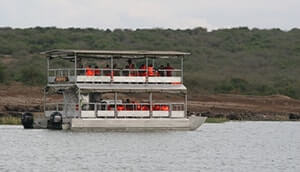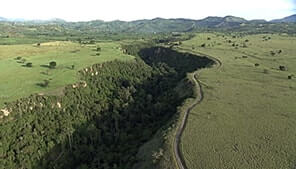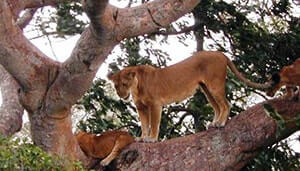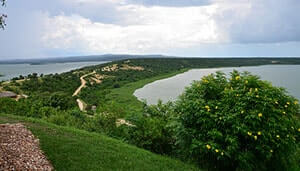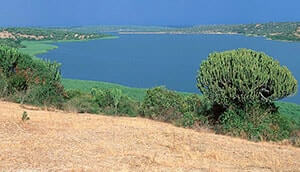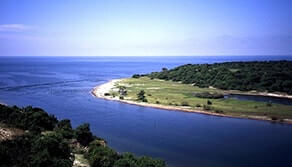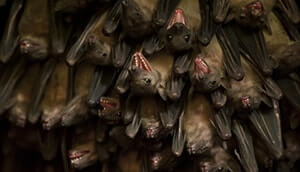Kasenyi Plains in Queen Elizabeth National Park
Kasenyi Plains are part of the famous Queen Elizabeth National Park in south western Uganda one of the most visited National Parks in the country. The flat plans are about 48 kilometers by road from Kasese town. The plains are on the western shores of the neighbouring spectacular Lake George adjoining to the area where the Kazinga Channel and this lake make a convergence.
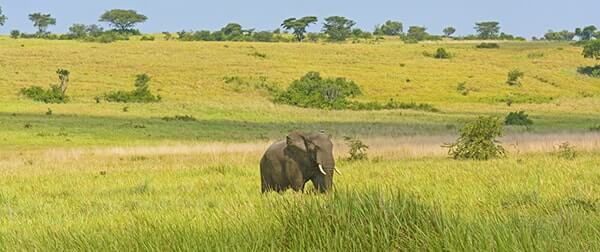
Kasenyi Plains, on the north-eastern side of Queen Elizabeth National Park are also known as the Kasenyi Sector. Kasenyi is mainly an open Savannah characterised by various wild animals with the Uganda Kob being the most dominant one. In fact this area is the major breeding area for the this mammal species in the park. Because the Uganda Kobs are many in the plains, Lions are frequently spotted here by tourists when taking game drives. The kobs are the main prey to the major cats in the park.
Lions in the park were rare to find but are now increasing in numbers are totalling around 200 and are commonly seen in the vast green plains. Kasenyi also supports an attractive variety of Savannah birds such as the red-throat spur fowls, grey-crown cranes and the yellow-throated long crow.
Opportunely, the biggest number of the Uganda Safaris done in Queen Elizabeth National Park is undertaken carried out in Kasenyi Plains due to the fact that lots of animals are found here. Being open plains, they are loved by animals at large. In the open, the prey can identify an enemy and run clearly and on the side of the hunters (lions & leopards); they can as well clearly spot a prey and run after it with ease. This open area is also very ideal for visitors interested in taking snapshots. Guided game drives in this area are not rushed to allow tourists enough to view and capture all the wild treasures with their eyes and on cameras. On uncommon occasions, you may essentially have an opportunity to watch lions chasing or capturing their prey.
The Mweya – Kasenyi plains have got the biggest numbers of animals in the park like Buffaloes, Lions, Elephants, Warthogs, Antelopes and Hyenas among others.
Related Attractions in Queen Elizabeth National Park
Kazinga Channel is a 32-kilometre long water channel that connects Lake George in the east to Lake Edward in the west. The channel is among the most paramount geographical features in Queen Elizabeth National Park with a magnificent view of the most vital wildlife in the park.
Kyambura Gorge – The Home Chimps
Kyambura Gorge is found in the far eastern side of Queen Elizabeth National Park in south western Uganda is roughly 1 km across and about 100 meters deeper. The gorge also known as the ‘Valley of Apes’ is drained by River Kyambura. Its a habitat to chimpanzees, other primate species and birds as well.
The Ishasha Sector found in the Southern part of Queen Elizabeth National Park is well-known for the amazing Tree-Climbing lions. Lions that hang in the big fig trees are an exceptional attraction and a key highlight of any Uganda safari tour this large national park. The Ishasha lions relax in the tree branches as they also spy on their preys from above.
Mweya Peninsula is found within Queen Elizabeth National Park on the northeastern shores of Lake Edward. The peninsula is the corner point where Kazinga Channel joins the lake. This beautiful piece of land surrounded by water either sides is approximately 66 kilometres by road from Kasese town.
Lake George found in western Uganda covers 250 square kilometres. The lake with an estimated depth of 2.4 meters is part of Africa’s Great Lakes system. Though the lake itself is not considered a Great Lake. This water body was named after a British Prince, George who later became King George V.
Lake Edward, the tiniest of the African Great Rift Lakes is positioned on the border between Uganda and the Democratic Republic of Congo. The lake is just few miles south of the equator. The first European to see the lake was Henry Morton Stanley, a Welsh explorer who visited the lake in 1888 during the Relief Expedition of Emin Pasha.
Maramagambo Forest is found in Bushenyi district and is a part of Queen Elizabeth National Park. The forest is prominently associated with the Bat Cave and the Python. The forest is bounded by two crater lakes, Lake Nyamasingiri and Lake Kyasanduka and is a home to the red-tailed monkeys, chimps and Bates’ pygmy antelope (Neotragus batesi) among others.

